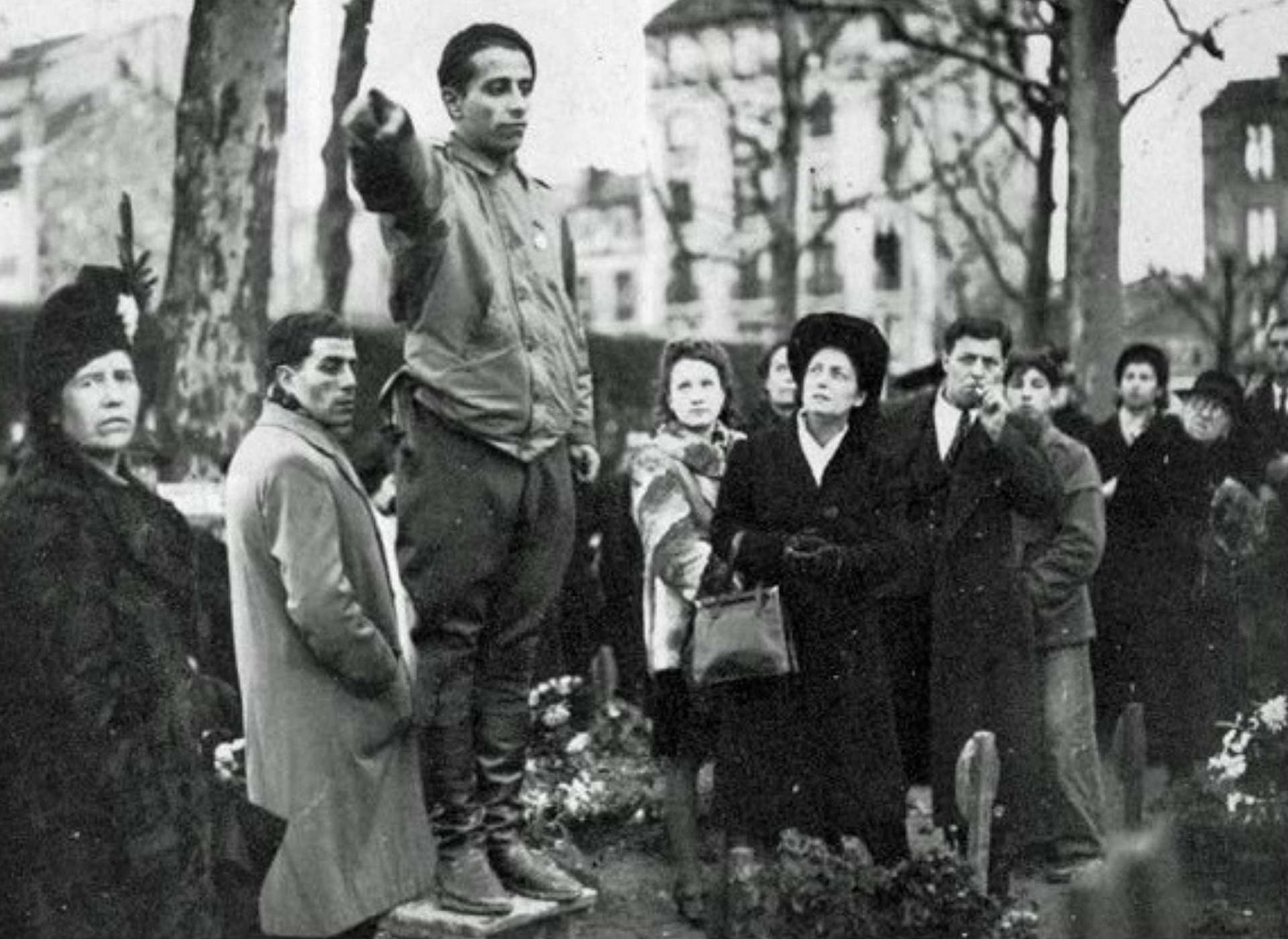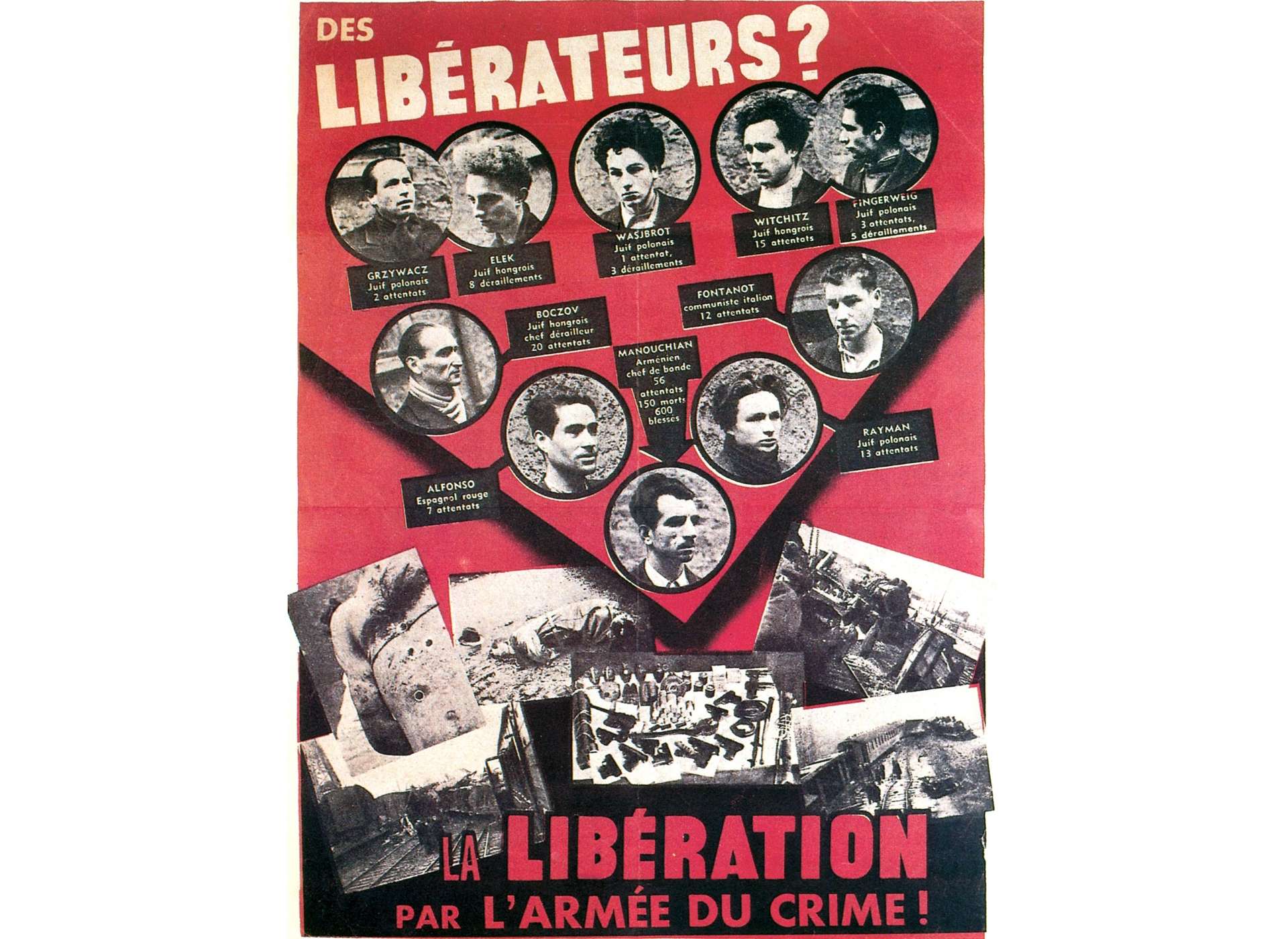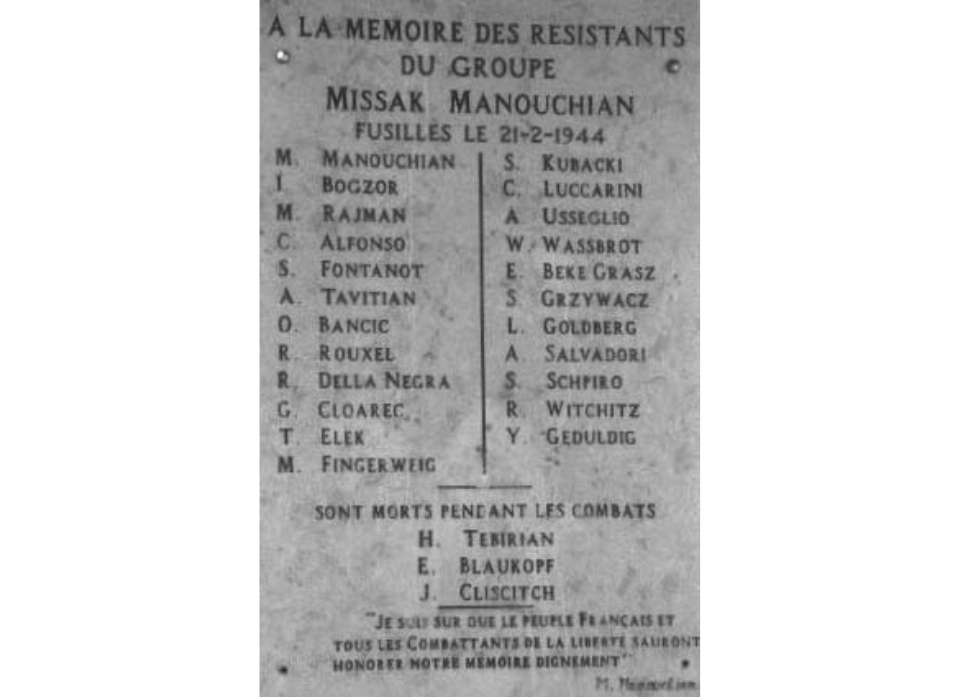Top image: Memorial to the executed members of the Manouchian Group. Courtesy Wikimedia Commons.
The death of Frank Blaichman, 96, at his home in Manhattan on December 27, 2018, was another painful reminder that resistance fighters, like Holocaust survivors and WWII veterans, continually vanish from our midst. Born Franek Blajchman in Kamionka, Poland, in December 1922, he fought against the Germans in an all-Jewish partisan unit based in his country’s eastern forests. News of Blaichman’s passing came only four months after the loss of Arsène Tchakarian, at the age of 101. Tchakarian once belonged to the “Manouchian Group” of the FTP-MOI, an astonishing group of foreign-born and Jewish partisans operating in France, which merits far more attention in the United States.
For much of his long life after World War II, Tchakarian made sure the stories of his comrades did not fall into oblivion. He lived to tell about the 23 fighters the Nazis executed at Fort Mont-Valérien, in the western suburbs of Paris, on February 21, 1944. As we consider the sacrifices made by American and Allied service members in the liberation of the European continent, we should also include what resistance organizations like the FTP-MOI accomplished in our reflections.
Main-d’Oeuvre Immigrée (Immigrant Workforce) or MOI was affiliated with the Francs-Tireurs et Partisans (Irregular Troops and Partisans) or FTP, a resistance group organized by the French Communist Party. The MOI’s roots lay in the prewar history of labor, in the efforts of the Communist-led General Confederation of Labor to organize foreign workers who had found jobs in France.
Its members came from Italy, Hungary, Romania, Poland, Bulgaria, Greece, and Spain, countries suffering under fascist dictatorships, pro-Hitler regimes, or German occupation. Many of them had been in France for years. An Armenian born in Turkey, Tchakarian had experienced with his family the nightmarish, genocidal nationalism of the Young Turks in World War I. He arrived in 1930, during the Great Depression, in Marseille as an apprentice tailor.
Many others in the organization were Jews, doubly hunted by the Nazis on racial as well as political grounds. In the MOI, they could take the fight to the very people who sought their extermination in France and across the European continent. Marcel Rayman came from Poland, Thomas Elek from Hungary, and Olga Bancic from Romania. They joined with men like the Italian Communist, Amedeo Usseglio, and Celestino Alfonso, who had fought against Franco in the Spanish Civil War. The fusion of these individuals in a single organization reflected the revolutionary internationalism of their Marxist politics. In an obituary for Tchakarian, The Washington Post referred to a speech he had given, recalling a “brotherly friendship which surpassed all that you can imagine” in the organization. Any hope they possessed of creating a liberated society rested on the defeat of Hitler.
As the final stage in Joseph Stalin’s betrayal of the October Revolution, the vile Nazi-Soviet Non-Aggression Pact allowed Moscow to exert pressure on communist parties not to confront the Germans. The French government had used the Pact as the pretext for banning the Communist Party in September 1939. That disastrous policy of nonresistance, in place for almost two years, ended with the Third Reich’s invasion of the Soviet Union on June 22, 1941. The French Communists, with its organizations like FTP-MOI, could now act.
What did it mean to “resist,” a word that, when used carelessly, can lose all coherence? Initially, knowing each other only by pseudonyms (Tchakarian went by “Charles”), many MOI members concentrated on producing anti-Nazi leaflets. As the deportation of Jews from France to the death camps started in 1942 and with the increasing conscription of hundreds of thousands of French workers to labor in the German war economy in 1943, they escalated their attacks. Derailing trains, sabotaging power lines, shooting or throwing grenades at German soldiers and police, or detonating bombs were the new means of insurgency.
In 1943, these partisans certainly heard the news about the stunning defeats suffered by the Axis powers: Stalingrad, North Africa, Kursk, Sicily, and Mussolini’s downfall. Yet the Allied invasion of France was not imminent, and they confronted an absolutely ruthless foe in the Nazi regime. That year the MOI in Paris, the focal point of the group’s activities, gained a new leader, Missak Manouchian. Using the pseudonym, “Georges,” Manouchian was a charismatic poet and, like Tchakarian, an Armenian. He had only gradually accepted the necessity of lethal violence. Once that decision was made, he showed determined leadership.
The “Manouchian Group,” as it became known, did not shrink from bold assaults on the German occupiers. Among them, Thomas Elek and Marcel Rayman had already achieved fame as especially daring fighters. Even before joining the MOI, Elek, a fiercely dedicated Marxist, prepared a special gift for the enemy. He hollowed out a copy of the first volume of Karl Marx’s Capital, inserted an explosive there, and left it on a shelf in a library used by the Germans. The devastation the bomb caused brought him into the ranks of the MOI. Elek later participated in the derailing of a German military train that killed or wounded dozens.
In March 1943, Rayman, with Manouchian and Tchakarian, carried out a grenade attack on German soldiers. When fear gripped Tchakarian and he could not hurl his grenade, Manouchian seized it from him and completed the task. On September 28, 1943, Rayman and several others from the organization caught up to Julius Ritter, the Nazi official overseeing the hated forced-labor program in France. They dispatched Ritter with several bullets. Manhunts and massive reprisals by the Germans and French collaborators ensued.
The security services of Vichy France, eager to assist the Gestapo, had been pursuing Manouchian and other members of the MOI. An attempt to kill Ernst Schaumburg, the German commandant of Greater Paris, had failed earlier that summer. Gathering information from informers and through torture, the Vichy police slowly closed in around the partisans. In November 1943, a wave of arrests swept up much of Manouchian Group. Tchakarian realized something dreadful had happened when Bancic did not appear for a secret meeting at the Gare d’Orsay rail station.
The captured partisans faced a terrible fate: interrogation, torture, trial, and execution. The trial and sentencing before a German military court took place swiftly and ruthlessly in February 1944. Manouchian defended himself and his comrades against the accusations they were foreign terrorists. They fought against Nazi Germany’s occupation of France, he countered, while many French citizens did nothing. The Germans meted out death sentences on February 21, to be carried out that afternoon.

Arséne Tchakarian speaking about the executions. Image courtesy Wikimedia Commons.
Due to the fine translations by Mitchell Abidor, we have access to the final moments of some of these MOI members. In a farewell note Rayman tried to comfort his mother:
“(W)hen you read this letter, I’m sure it will cause you extreme pain, but I will have been dead for a while and you’ll be consoled by my brother who will live happily with you and give you all the joy I would have liked to give you. Forgive me for not writing at greater length, but we are all so joyful that it’s impossible to think of the pain you will feel. I can only say one thing, and that’s that I love you more than anything in the world, and I would have liked to live for your sake alone. I love you, I kiss you, but words can’t describe what I feel.”
Writing to his wife, Melinée, Manouchian said, “I joined the Army of Liberation as a volunteer, and I die within inches of Victory and the final goal. I wish for happiness for all those who will survive and taste the sweetness of the freedom and peace of tomorrow. I'm sure that the French people, and all those who fight for freedom, will know how to honor our memory with dignity.”
He refused to hate the German people for the crimes perpetrated under Hitler’s dictatorship, hating only those who denounced him and his comrades.
Manouchian, Rayman, Elek, Usseglio, Alfonso, and 17 others were shot by a German firing squad around 3:00 p.m. at Fort Mont-Valérien on February 21. A twenty-third member was subsequently killed. At least 1,000 other resistance fighters perished at the same site. A French law against the execution of women temporarily spared Olga Bancic. The Nazis, unfazed by such constraints, transported her to Stuttgart, Germany, where she was beheaded three months later.
It did not suffice for the Nazis, though, to kill the partisans. They attempted to turn public opinion in France against their legacy. The notorious Affiche Rouge (“Red Poster”) they created demonstrates how far they were willing to go. With the main caption asking, mockingly, “Are these Liberators?” the poster denounces the partisans as the “Army of Crime.” Manouchian was labeled the chef de bande (“gangleader”). However, the poster generated more veneration for the fighters than revilement. Many French inscribed Morts pour la France (“Died for France”) on the image to show their respect for their sacrifice.

The Affiche Rouge (“Red Poster”). Image courtesy Wikimedia Commons.
Tchakarian did not share their fate. According to historian David Broder, a policeman aided him in getting out of Paris and making it to Bordeaux. The next year, he supported the 4th Armored Division of General George Patton’s Third Army in liberating the town of Montargis, 70 miles south of Paris. Two days later, on August 25, 1944, Paris itself, the center for the Manouchian Group’s actions, was liberated. Photographs from the time show Tchakarian giving speeches about his fallen comrades soon thereafter. Over the following decades, he would receive much help with this endeavor.
In 1997, Robert Badinter, an attorney whose father perished in the Sobibor death camp, persuaded the French parliament to build a monument to those resistance fighters put to death at Fort Mont-Valérien that would include the Manouchian Group. The 2009 film L'Armée du Crime (“Army of Crime”), directed by Robert Guédiguian, kept alive the story of Manouchian, Rayman, and the FTP-MOI. As important as the film was, the tireless, decades-long efforts of surviving members, especially Tchakarian, ensured the group was not forgotten. In an exchange with the newspaper Le Figaro, Tchakarian had described himself as “sort of the last of the Mohicans, so they say.” The French government recognized him as an officer of the Legion of Honor in 2012, promoting him to commander five years later. Tchakarian’s passing, like that of Frank Blaichman, warrants our respect and understanding for what they risked to free Europe from fascist rule.
Jason Dawsey, PhD
Jason Dawsey, PhD, is ASU WWII Studies Consultant in the Jenny Craig Institute for the Study of War and Democracy.
Cite this article:
MLA Citation:
APA Citation:
Chicago Style Citation:





![Max Fuchs, New York City cantor, sings as Rabbi Sydney [sic] Lefkowitz, Richmond, VA, conducts the first Jewish services from Germany.](/sites/default/files/styles/max_650x650/public/2025-10/image1.jpg)



